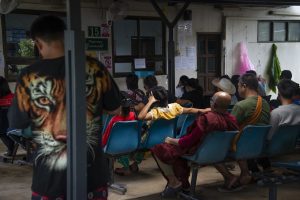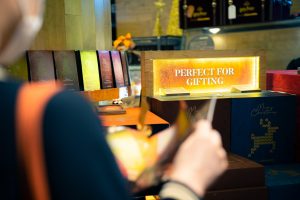Top image: Nathaniel Yeo/Unsplash
If you’ve been to Changi Airport’s Jewel, you’ll know it’s built to impress. From the dense indoor forest to the waterfall cascading through the oculus of the torus, this hermetically-controlled space is intentionally designed to dazzle the visitor and coerce them to bask in its technological glory.
It is 30+ degrees outside, but there’s comfort here at a pleasant 23 degrees. You crane your neck up and see the blue expanse of sky as you stand surrounded by a mise-en-scène of trees, palms, and shrubs, all real but, in many ways, artificial.
Everything here is immaculately programmed and manicured. It’s a perplexing feat given that this is part of an airport and simultaneously a tourist attraction in its own right that seamlessly connects the existing terminals.
An airport is the front door to any country, insofar that it is both the first and last memory travellers will have of a place. But, as with other aerotropolises, Jewel Changi overturns the expectation that an airport is merely a place that people pass through to reach their destination—it is the destination itself.
And as the pandemic starts showing signs of waning and travel numbers climb on a steady upward trajectory, it is perhaps time to reconsider the current status and true nature of Jewel Changi since it opened more than three years ago.
What sort of place is Jewel, really?
What Changi Airport has done with Jewel has shifted our understanding of the airport as a place of transit, and it has shed light on how we, as humans, travellers, and residents of the country, relate to the airport in light of this shift.
Marc Augé writes of the “non-place” in his seminal text “Non-Places: An Introduction to Supermodernity”, wherein concepts of organic, anthropological places are in stark contrast to non-places, which are decidedly non-organic.
Anthropological places are social by nature—humans relate to their history, heritage, and each other within such spaces. They are relational, historical, and concerned with identity—unlike non-places.
Augé writes that non-places such as bus interchanges, train stations, and airports are only concerned with purpose—they are “formed in relation to a certain end”.
He also posits that they come with useful instructions that are likely prescriptive, prohibitive, and informative, such as “No Smoking” or “EU passports holders to the left-hand lane”.
Up until the last decade or so, airports were conventionally understood as places to pass through to get to a destination. Suppose we were to consider the fairly recent innovation in airports and their extensions in the form of malls and tourist attractions. In that case, Augé’s model of non-places might suggest Jewel as an organic and social place, merely a means to an end.
It exists between that grey area of definitions—neither a non-place nor anthropological, but poetically straddling the fine line that theoretically separates both.
“Strollology”
In asking what Jewel is, we may also consider aviation academic and consultant John D. Kasarda’s concept of the “aerotropolis”, which envisions a sub-region within a metropolis, like Singapore, whose infrastructure, land use, and economy are centred on an international airport. It’s a more contemporary take than Augé’s theory from the early 90s.
In a Financial Times article, architecture critic Edwin Heathcote aptly summarises the aerotropolis, introducing international airports which seem to skirt or fully realise the concept, such as Singapore’s Changi, Dubai International and Korea’s Songdo.
For Heathcote, the phenomena is a logistics-centred, efficiency-obsessed concept, writing that “it’s a picture of a city in which humans are reduced to units, to patterns of movement predicted by algorithms… the architecture becomes an efficient funnel… we are the flow”.
He envisions a future (or a present) that, for efficiency, harnesses design to make the flow of physical and human resources as friction-free as possible, illustrating the aerotropolis as a dystopian realisation of a highly-efficient, pragmatic machine of a city.
Heathcote’s and Augé’s approaches help us make sense of Jewel and further determine how the airport stands in relation to Singapore’s society and economy, elucidating the shifting anthropological, architectural, social, and economic models of airports in general.
What perhaps provides nuance and positions Jewel as a space which defies anthropological categorisation would be the way Singapore’s residents relate to the space—as a place of brief, repeated lingering and a space for the practice of “strollology” wherein a relationship with the area is developed.
The poster child of the Garden City
The lack of prescriptive instructions within Jewel (such as “EU passports holders to the left-hand lane”) with which airports are typically associated is notable.
Instead, in its place, a somewhat organic element is subtly introduced both in the way people seem to relate to the space and with each other within the space, particularly in Jewel’s green areas, mirroring the function of the planned greenery of the Garden City vision.
By intentionally creating areas for rest and recreation—most of which can be accessed free of charge—Jewel becomes an organically social space for people to gather without an apparent price tag.
Still, the juxtaposition of such vast “free” spaces with the slew of mid-to-high-end shops directly adjacent to it illuminates the fact that Jewel seems to be categorically distinct from your standard shopping mall—or even the new variety of airport “malls”. Those tend toward explicit consumerism and capitalist consumption with flashy advertisement billboards and chain retailers.
In this light, Jewel can then ostensibly be understood to cultivate and further interpersonal relationships in ways that the conventional airport and mall do not. Thus, by Augé’s terms, it may be deemed relational.
Still, it is social in that human relationships may be organically fostered and cultivated therein by gathering and relating to one another.
Progression towards sociality
This may also be understood as building on the idea of the airport as—contrary to Augé’s scepticism—an inherently social and relational space. Though certainly concerned with the purpose of transit, airports seem to allow people passing through them to relate to each other more than in other transit hubs, such as bus interchanges.
Indeed, the airport as a place of reunion (and thus inherently relational) has become a fundamental element ever since leisure travel became mainstream. In fact, it has attained a somewhat symbolic status in popular culture à la Love Actually’s rom-com portrayal of busy Heathrow terminals around Christmas time.
Building on the airport’s existing social facets of human relationships, Jewel seems to move from the airport being a space within which loved ones briefly reunite and bid farewell to one in which longer durations of stay are acceptable and, in fact, highly encouraged.
In charting such a progression towards sociality, Jewel also challenges Heathcote’s view of aerotropolises as almost dystopian, shifting the conversation from the aerotropolis solely as an efficient logistical system to a social hub away from Singapore’s central and downtown areas.
Jewel as a brand
If we reflect temporally on the notion of the airport, we may be able to examine how the airport as both a space and a concept has and will continue to evolve with human development.
As travel becomes increasingly efficient, the world more globalised, and cities more densely populated, what we understand as an airport or an aerotropolis will change.
In particular, certain aspects of the airport have taken on a level of fluidity at current stages of globalisation and capitalism—the airport is now a mall, harnessed to capitalistic ends.
In the case of Jewel, it is unmistakably realised as a brand. Imbued with the characteristics and identity of a technologically-advanced, well-pruned garden city, Jewel eschews the overt capitalism of an airport “mall” for a somewhat more elegant and understated form, yet simultaneously aligning itself with a larger agenda of economic opportunity.
Indeed, as much as Changi is Singapore’s “front door”, Jewel is quickly becoming the face of a distinctly Singaporean brand and thus, too, can be seen to have been built and constructed to service and attract economic opportunity.
But in the sense that the airport is and will remain an inherently relational space, Jewel is then simultaneously a reinterpretation and embodiment of both the static and fluid elements of the airport: a place of transit, of reunion, and lately, the mall and free-for-all space for gathering.
This allows Changi to continuously reposition itself for the resident and the traveller by serving the distinct yet interrelated functions of transport, consumption, and social relations.
Perhaps Jewel’s potential to become more than a silhouette on a souvenir keychain comes down to its propensity to be humanised. By forgoing a set of prescriptive instructions, Jewel invites residents and travellers alike to relate to and engage with it and with each other within the space, in whatever way they may wish.
And thus, by doing so, Jewel Changi can truly grow into itself.







